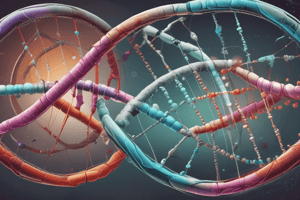Podcast
Questions and Answers
What is the function of the phosphate group attached to the 5' end of a DNA molecule?
What is the function of the phosphate group attached to the 5' end of a DNA molecule?
- To facilitate the formation of phosphodiester bonds (correct)
- To mark the starting point of DNA replication
- To stabilize the sugar-phosphate backbone
- To provide a binding site for enzymes
What is the type of bond that links nucleotides together in a DNA molecule?
What is the type of bond that links nucleotides together in a DNA molecule?
- Phosphodiester bonds (correct)
- Ionic bonds
- Hydrogen bonds
- Peptide bonds
Which of the following is a result of the directionality of DNA molecules?
Which of the following is a result of the directionality of DNA molecules?
- The initiation of DNA replication
- The formation of a double helix structure
- The stability of the sugar-phosphate backbone
- The transmission of genetic information (correct)
In RNA, which base pairs with uracil (U)?
In RNA, which base pairs with uracil (U)?
What is the function of the hydroxyl group at the 3' end of a DNA molecule?
What is the function of the hydroxyl group at the 3' end of a DNA molecule?
What determines the genetic information encoded in a DNA molecule?
What determines the genetic information encoded in a DNA molecule?
What is the significance of the ratio of A:T to G:C base pairs in a DNA molecule?
What is the significance of the ratio of A:T to G:C base pairs in a DNA molecule?
What are the three components of a nucleotide?
What are the three components of a nucleotide?
Flashcards are hidden until you start studying
Study Notes
5'-3' Directionality
- DNA and RNA molecules have directionality, with one end designated as 5' (five prime) and the other end as 3' (three prime)
- The 5' end has a phosphate group attached to the 5th carbon of the sugar molecule
- The 3' end has a hydroxyl group attached to the 3rd carbon of the sugar molecule
- This directionality is important for DNA replication, transcription, and translation processes
Phosphodiester Bonds
- Phosphodiester bonds are the chemical bonds that link nucleotides together in a DNA or RNA molecule
- These bonds form between the 3' hydroxyl group of one nucleotide and the 5' phosphate group of another nucleotide
- Phosphodiester bonds are strong covalent bonds that give stability to the DNA or RNA molecule
- They are also responsible for the formation of the sugar-phosphate backbone of the molecule
Base Pairing Rules
- In DNA, adenine (A) pairs with thymine (T) through two hydrogen bonds
- In DNA, guanine (G) pairs with cytosine (C) through three hydrogen bonds
- In RNA, adenine (A) pairs with uracil (U) instead of thymine (T)
- Base pairing rules are crucial for the transmission of genetic information and the stability of the DNA or RNA molecule
Nucleotide Composition
- A nucleotide is composed of three components:
- A sugar molecule (deoxyribose in DNA, ribose in RNA)
- A phosphate group
- A nitrogenous base (A, T, G, C, or U)
- The sequence of nucleotides determines the genetic information encoded in a DNA or RNA molecule
- The ratio of A:T and G:C base pairs can be used to identify the melting temperature of a DNA molecule, which is important for PCR and DNA sequencing techniques
5'-3' Directionality
- DNA and RNA molecules have 5' and 3' ends, which are essential for DNA replication, transcription, and translation processes
- The 5' end has a phosphate group attached to the 5th carbon of the sugar molecule, while the 3' end has a hydroxyl group attached to the 3rd carbon
- Directionality is crucial for the accurate processing of genetic information
Phosphodiester Bonds
- Phosphodiester bonds link nucleotides together in DNA and RNA molecules, forming a strong covalent bond between the 3' hydroxyl group and 5' phosphate group
- These bonds create the sugar-phosphate backbone of the molecule, providing stability and structure
- Phosphodiester bonds are essential for the integrity of DNA and RNA molecules
Base Pairing Rules
- Adenine (A) pairs with Thymine (T) through two hydrogen bonds in DNA
- Guanine (G) pairs with Cytosine (C) through three hydrogen bonds in DNA
- In RNA, Adenine (A) pairs with Uracil (U) instead of Thymine (T)
- Base pairing rules are critical for the accurate transmission of genetic information and DNA/RNA stability
Nucleotide Composition
- A nucleotide consists of three components: sugar molecule (deoxyribose in DNA, ribose in RNA), phosphate group, and nitrogenous base (A, T, G, C, or U)
- The sequence of nucleotides determines the genetic information encoded in a DNA or RNA molecule
- The A:T and G:C base pair ratio affects the melting temperature of DNA, which is crucial for PCR and DNA sequencing techniques
Studying That Suits You
Use AI to generate personalized quizzes and flashcards to suit your learning preferences.




